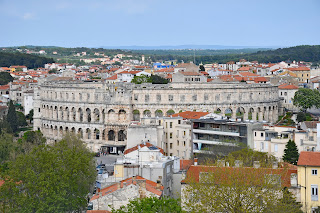Balkans Road Trip: Day 4 – Poreč, Rovinj, and Pula
We ate breakfast at our hostel with utmost speed to avoid awkward small talk with our fellow travellers and sped back to Croatia. One of the things I have noticed about roads in Italy and Slovenia is that the on and off-ramps for highways are unpleasantly short and narrow. Besides saving marginal costs on materials, I really cannot think of a reason for why this is so. Nevertheless, our subsequent driving up and down the winding country paths of the Croatian coast was equally challenging, with plucky cyclists acting as occasional obstacles and creating pileups long behind their backs.
Poreč is well-known for its UNESCO-listed Euphrasian
Basilica, which traces its history to a secret 4th century church.
It has been the site of various construction projects from then until the
nineteenth century, with various additions made to the compound throughout the
ages. One of the basilica’s primacies is that it is the earliest example of a
triple-apsed church in Western Europe. Its most remarkable artistic features
are its mosaics, which date to various ages and range from bi-coloured floor
details to bright and golden apse decorations.
While finding parking
in Poreč had been easy, leaving the car park turned out
to be a task worthy of an escape room. One of the payment machines was broken,
the other froze up, and the office was not staffed. While helplessly returning
to our car, I spotted a worker operating on the bars at the exit and ran
towards her. I explained our situation to her, and she kindly accompanied me to
the machines. Of course, by then the second machine had unfrozen and I felt
rather silly, so I thanked the worker profusely and hurried away to another
town where we could benefit from our anonymity.
By the time we started
walking around Rovinj it had started to drizzle. The town was still quite
pretty, but we did not spend as much time touring as we otherwise would have.
Entering the centre through Balbi’s Arch, we walked along a few old streets and
wandered up to the Church of Saint Euphemia before walking down again along
different quaint paths. One interesting thing I have noticed throughout Istria
is the number of dual-language signs in Croatian and Italian, which indicates
the continued presence of an Italian minority in this historically diverse
area. Either due to that or Italian tourism, many people here also seem to
speak Italian fluently.
I was already a little
exhausted by the time we departed again, but the final stretch of the road was
still before us: we finished the day’s journey with a drive to Pula. The town
is yet another ancient settlement, holding treasures like the Arch of the
Sergii and a giant mosaic showing the Punishment of Dirce. Her crime was
persecuting her niece, whose sons had been fathered by Zeus and who ended up
killing Dirce by tying her to the horns of a bull. We also visited the Temple
of Augustus, which was used as a church, granary, and archive throughout the
town’s long history.
After visiting
the temple, we climbed up to Fortress Kaštel, a seventeenth-century defensive structure built by the Venetians. The
Castello – and especially the tower within it – offers good views of the
surrounding town, including Pula Cathedral, Saint Anthony’s Church, and the
Roman Amphitheatre. Our steps led to the last of these, briefly stopping at
Tito’s Park, which commemorates the erewhile Yugoslav leader and his fellow
partisans. As for the Amphitheatre, I was impressed by how giant and
well-preserved it was, allowing people to sit down in the cavea and contemplate
the bloodlust their ancestors must have felt watching slaves battle each other to
the death.























































Comments
Post a Comment